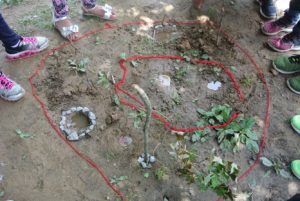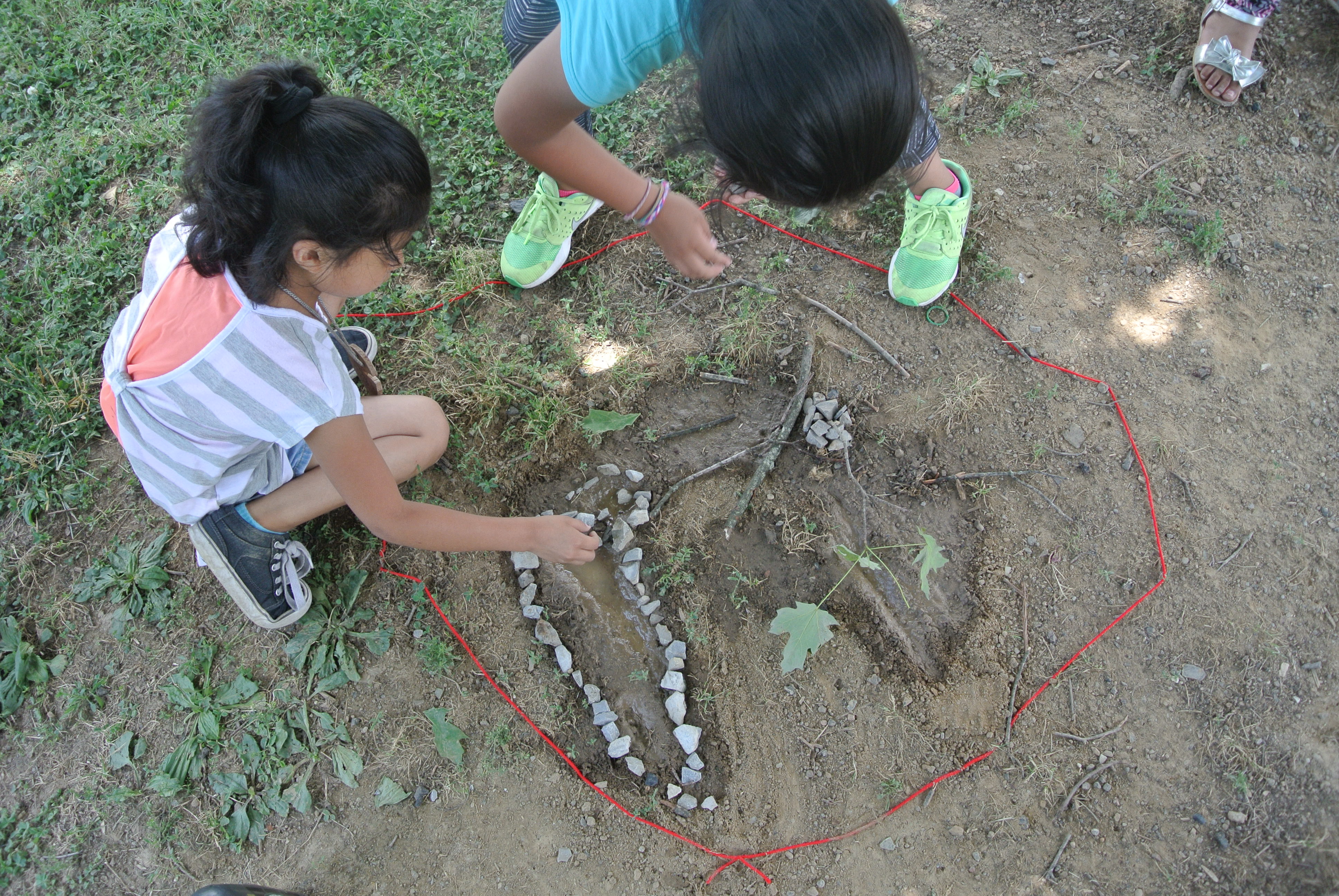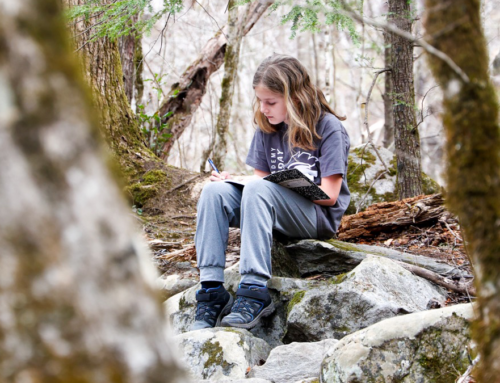What makes a park exceptional? Here in Great Smoky Mountains National Park, we value biodiversity, cultural heritage, environmental health and ecology, stewardship, research, and so much more. Our park is prosperous in mountains, recreational activities (such as hiking and horseback riding trails), animal encounters, citizen science and research opportunities, and historical sites to explore. These are just a few of the reasons why Franklin D. Roosevelt dedicated this land as a national park in 1934. Great Smoky Mountains National Park covers 522,427 acres, but do all parks have to be this large to make an impact? Do parks have to have wild animals, cultural heritage, or mountains to be a space worth protecting? In this lesson you and your students will have a chance to discuss these questions and come to your own conclusions through creating your own mini national park in your schoolyard.
INVITE your students to evaluate what a great park is and does by taking them out to the schoolyard. Create a Mind Pie on chart paper where your students can rate different characteristics that they believe make parks exceptional. This Mind Pie can incorporate broad and specific categories, including: biodiversity (e.g., plants and animals from all levels of the food chain), historical sites, playsets, roads for 4×4 vehicle use, rangers, distance from a city, etc. Before students see the Mind Pie, have them collect 6 rocks, 6 leaves, and 6 pieces of stick. When they return, let them take some time to read the Mind Pie and mentally evaluate the various characteristics of an exceptional park. Next, let them rank the characteristics using their natural items. Make sure that there is a key on the chart paper that identifies the meaning and value for each object. A rock will be placed on sections of the mind-pie that the student believes need to be included in an exceptional park, leaves will be placed on sections that could be included, but do not have to be included in an exceptional park, and sticks are placed on sections that are not needed to make a park exceptional. Instruct your students to continue placing their votes on each piece of the Mind Pie until every natural item has been used. After the Mind Pie votes have been cast, begin a discussion around the pieces of the Mind Pie: Why should certain characteristics be or not be included in an exceptional park? Why are certain characteristics worth protecting and preserving over others? Assess where students placed the most rocks or sticks and ask why they did so. The goal is to come up with a new list of values or characteristics, together, that could all be used to make a designated area of the schoolyard an exceptional space worth protecting, like a national park. Create this new, collaborative list on a piece of chart paper and display it for the whole class to reference throughout the activity.
EXPLORE Let students explore the schoolyard, either individually or in pairs, for a place that they believe fits all of the qualifications they listed and would be perfect for their Mini National Park. Encourage your students to let go of the notion of there only being one right answer, and instead, use their imaginations and creativity as they explore. Remind them to revisit the list they created together for ideas on some key characteristics of an exceptional mini national park. This step encourages students to see their schoolyard as small pockets of habitats that are worth protecting and preserving.
WONDER Have students assess and discuss the impacts of human activities on these new Mini National Parks. What components of the food chain are present within this ecosystem? Is any energy being created and transferred within the ecosystem? If so, how is energy driving this ecosystem? Is there a system that could be added to the ecosystem that would capitalize on this energy, or is the space you picked for your national park a homeostatic ecosystem?
 CREATE Hand out pieces of string that has been tied into a circle to each student or each pair of students, so that they can create their own Miniature National Park. The strings can be anywhere from 4-6 feet in length before tying, depending on how large you want your students’ parks to be. Explain that the location of their Mini National Park is up to the student(s), but that they are limited by what they can fit inside of the string. Encourage students to chose spaces with diversity of vegetation, unique landforms, and places that the ants, rolly pollies, and worms would love to explore. Once a spot is chosen, students may make minor changes to their park by digging holes, building structures with natural items they find around the area, creating pools, or adding entrances.
CREATE Hand out pieces of string that has been tied into a circle to each student or each pair of students, so that they can create their own Miniature National Park. The strings can be anywhere from 4-6 feet in length before tying, depending on how large you want your students’ parks to be. Explain that the location of their Mini National Park is up to the student(s), but that they are limited by what they can fit inside of the string. Encourage students to chose spaces with diversity of vegetation, unique landforms, and places that the ants, rolly pollies, and worms would love to explore. Once a spot is chosen, students may make minor changes to their park by digging holes, building structures with natural items they find around the area, creating pools, or adding entrances.

REFLECT Have your students draw and label their Mini National Parks in their journals, once their creation is complete. Every student should create a journal entry, even if they worked in pairs. They should give their park a name and write about who they think would visit their park and why. Evaluate student understanding and comprehension by asking questions such as: Why did you choose this space? Why did you put that structure into your park? What is your favorite part of your park? What was the reasoning behind adding or not adding an energy system? Students answers will reflect their thought processes as they created their Miniature National Parks.
SHARE Lead your students on a gallery walk around to all of the Mini National Parks, giving the park creators pride in their work, as well as the ability to see what everyone else created and added to their Mini National Parks. Students have this time to critique their own park, explain their thought processes, and brainstorm what could make their space more inclusive and/or more specific to a certain target activity or audience.
*NOTE: As an extension to this exercise, you can allot a certain amount of money for each park. Students can use their allotment to buy materials for buildings, maintaining trails, recreational activities and structures, or historic preservation. They will need to think critically about where they decide place their parks in the schoolyard, so that they won’t have to spend all their money on maintenance. (Incorporating an allotment of money would add a mathematics element to the exercise that would cover other state academic standards not listed below.)
Coordinating Academic Standards
SL.CC.1 – Prepare for and participate effectively in a range of conversations and collaborations with verified partners, building on others’ ideas and expressing their own clearly and persuasively.SL.PKI.4 – Present information, findings, and supporting evidence such that listeners can follow the line of reasoning: the organization, development, and style are appropriate to task, purpose, and audience.W.TTP.1 – Write arguments to support claims in an analysis of substantive topics or texts, using valid reasoning and relevant and sufficient evidence.
W.TTP.2 – Write informative/explanatory texts to examine and convey complex ideas and information clearly and accurately through the effective selection, organization, and analysis of content.
W.PDW.4 – Produce clear and coherent writing in which the development and organization are appropriate to task, purpose, and audience.
Science
4.PS3.3 – Describe how stored energy can be converted into another form for practical use.
4.LS2 – Ecosystems: Interactions, Energy, and Dynamics
6.LS2 – Draw conclusions about the transfer of energy through a food web and energy pyramid in an ecosystem.
6.ESS3.3 – Assess the impacts of human activities on the biosphere including conservation, habitat management, species endangerment, and extinction.
BIO2.LS4.16 – Investigate the role of different plant types in ecosystem building and maintenance (examples: soil formation, inhibition of erosion, oxygen production, carbon sequestration, habitats).
ESS.ESS2.11 – Obtain, evaluate, and communicate information about human or natural threats to Tennessee.
ECO.LS2 – Ecosystems: Interactions, Energy, and Dynamics
EVSC.LS2 – Ecosystems: Interactions, Energy, and Dynamics
EVSC.LS4 – Biological Change: Unity and Diversity
EVSC.ESS3 – Earth and Human Activity




![A Deep Dive Into Wetlands [Free Lesson Plan]](https://gsmit.org/wp-content/uploads/2024/02/madeline-blog-cover-500x383.png)
![Are You a Math and Science Person or a History and English Person? [Free Lesson Plan]](https://gsmit.org/wp-content/uploads/2024/01/Girls-in-Science-Erin-Rosolina-3-1-500x383.jpg)

